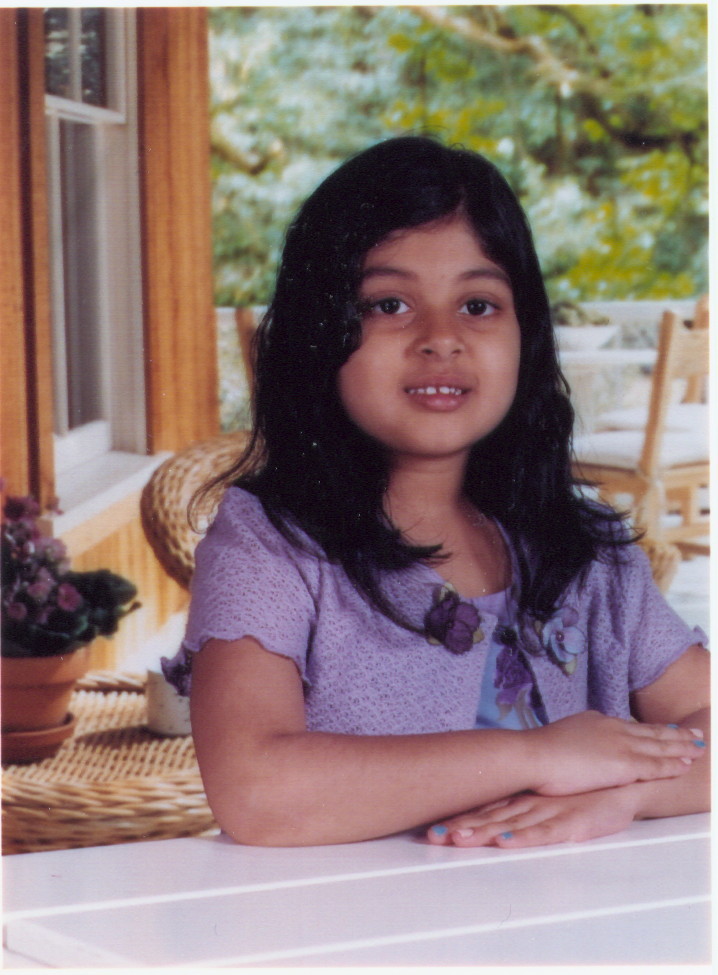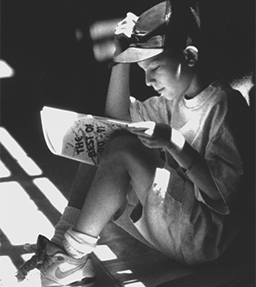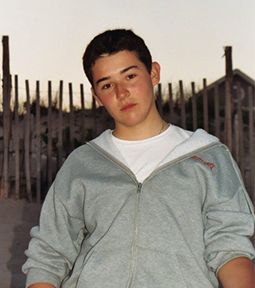
Swetha was born in Madras, India on May 5th 1994. From that instant she captivated the whole family with her beautiful smile and chubby cheeks. Since she was a long awaited one, she was dear to everybody. She was just 10 months when we decided to move to U.S for few years because of my career. She was not only an exceptionally beautiful, adorable girl but also was very smart growing day by day delighting her mom and dad in everything she did. She showed incredible maturity beyond her age. She became eloquent in her mother tongue Tamil, and English. She was an angel right from the Heaven.
In 1997 Swetha’s baby brother, Srivatsan, was born. Though she was just 3 years that time, she was magnanimous to share her pleasures and toys with him. She was not only a loving sister but also a caring friend, mentor and role model for the little boy. She could take care of him, play with him and also teach him some important lessons of life.
Swetha was six-years-old, studying first grade, and loved her teacher Ms.Rourke. She loved reading books and very meticulous in doing homework. She was a model student and was always in honor roll. She was so energetic and enthusiastic about all out-door activities. She loved swimming, skating, classical Indian dance, Bharatha Natyam. She liked Washington D.C., especially the Monument, the kite festival and cherry blossoms.
My wife and I felt so blessed and lucky and life could not be better and we thanked God daily for the gifts in terms of our children. That is time the ‘karma’ took over. In January 2001, Swetha’s school called because she had vomited in the class. From then on, we received calls routinely once or twice a week. Swetha had long and sustained series of antibiotics and we thought the vomiting was caused by antibiotic overuse. Her pediatrician did not know anything was wrong. Several weeks passed in vain. Then for the next few weeks we went to the emergency room, got second opinions, and stomach scans, etc. Her symptoms were not getting better. Every morning she would say, ” I’m not feeling good,” complaining of early morning headaches, and was losing her appetite. We were so worried and concerned that we were not able to find the root cause of her illness. Our feelings of frustration and helplessness mounted. When we went to the park near Reagan National Airport in Arlington Virginia to see the airplanes, she could not lift her head to see the planes. Then we knew something was seriously wrong.
On April 16th 2001, we went to Children’s National Medical Center (CNMC), Washington D.C. I had heard about this hospital through a friend. Therefore, we thought we could get a solid second opinion from CNMC about her condition. The emergency room sent Swetha for a CT scan of her brain. My wife was inside the room with Swetha and I was outside in the waiting room praying. After some tests and what seemed to be an eternity, we met Dr. Philip Cogen, a neurosurgeon, who had Swetha’s CT scans in his hand. He took us aside and said, “Your daughter has a brain tumor,” without any preamble. I felt my head was spinning wildly and I was about to faint, so the rest of what he said was not heard. I felt like a sharp knife was piercing my heart, it was the worst news a parent could hear. My wife was crying uncontrollably. Things were happening so fast that we could not even think straight. Swetha was immediately admitted to the hospital and Decadron was prescribed to control the swelling caused by the tumor. Though it was a shocking diagnosis, it instantly explained every symptom she had. After an MRI, we were told it was a “low grade” astrocytoma in the brainstem. Based on the scan, Dr. Philip Cogen was hopeful that most of the tumor could be removed. Out of the gloom, there was a glimmer of hope.
Swetha was cheerful and chatty on the day of the surgery, April 18, 2001 not realizing she was about to undergo a risky and complex operation. We prayed outside the surgical theater and waited nervously for the surgeon to come out. It took several hours and finally Dr. Cogen came out. We tried to read his face keenly for clues. He said the tumor turned was “diffused,” meaning it was intermixed with normal cells and therefore, he could do only “biopsy.” It was also in the brain stem, which controls almost every primitive function of the body including balance, heart rate, blood pressure, co-ordination, facial movement, swallowing. Surgery in this area of the brain could cause permanent neurological damage. This was a major blow and set back which threw our glimmer of hope out the window. Will we ever hear good news? Apparently not.
Dr. Roger Packer (neurologist), Dr. Tobey MacDonald (oncologist), and Debbie Lafond (oncology nurse practitioner) met with us and explained the pathology report based on the biopsy sample. The tumor type was fibrillary astrocytoma, which appeared as benign under the microscope, the high MIB-1 labeling index was suggestive of a highly malignant tumor. Our hearts sank and our hopes dimmed further. After surgery, Swetha had to re-learn walking and balance. She had an incessant appetite, lack of sleep, nausea, night sweats and mood swings. Swetha started radiation treatments at Georgetown Hospital, Washington, D.C. and missed two months of school. The doctors and the technicians at Georgetown marveled at her patience and compliance through the whole ordeal. She was a model “patient.”
Swetha’s tumor was in control and she was looking forward to her return to school. We hoped she would pull through at least the first 18 months from the date of diagnosis. In January 2002, the headaches and nausea were back. The MRI showed the tumor was progressing. Doctors told “the tumor has recurred i.e. progressed” based on size. It was terrible news and a major setback. Based on what little I knew, there were not many options with her kind of brain tumor, except chemotherapy which was not always effective. Surgery and radiation treatment options were ruled out. Our beautiful young daughter, Swetha, was facing a life-threatening situation. A situation no parent should face. I spent hours reading about alternative and complementary treatments. There were bogus claims, outright frauds, and quackery. Some like Siddha medicines practiced in India were genuine but there was no scientific data for me to make an informed decision. The emotional toll was enormous and we tried hard not to show that in our care for Swetha. She was putting up with this, still smiling and playing with her brother now.
We were advised to participate in a clinical research study with some combination chemotherapy drugs. There were no guarantees or promises that this would work. The tumor was growing rapidly and we were left with no other options. Her chances of survival were pretty bleak. It was a matter of time. The only advice was to fight the tumor “head on” aggressively. My wife and myself had a nightmarish week unable to make up our minds on the next course of action. If we don’t take the next step, it was like inviting disaster soon. The doctors told us there was no right or wrong decision, the most important thing was her quality of life. Administering chemotherapy medications required placement of a broviac that requires surgery. We debated going back to India, but were afraid to leave the medical care that the US had to offer her. Beside the logistical problem of winding up, relocating and settling in a short notice, we were deeply worried about her growing tumor. We had sleepless nights and consulted with many people and doctors before we decided to go with the Chemo. After two cycles of chemotherapy, she lost lot of weight, turned thin and pale, and suffered from severe stomachaches. Her scan after two months confirmed that the tumor was still progressing. We were asked to stop the medications and come off the clinical research protocol. She was not allowed any medication or any other study for at least a month (washout period). During this break, we took Swetha to her favorite vacation spot, Disney World at Florida. This was sponsored by Make-A-Wish Foundation. She had the time of her life at Disney. It was a wonderful, fun-filled, exciting holiday vacation. The treatment was on hold while Swetha celebrated her 8th birthday with Mickey and Friends.
When Doctors said she would be eligible to join the clinical study based on oral drug Gleevec, we were excited. It looked like miracle drug full of promises, expectations and hope as FDA rapidly approved it for Leukemia. Even though there was no known data for effectiveness against brain tumors (especially in children) it appeared as a good drug. Within two weeks into this, her headaches started noticeably prominent and nausea increased. In the third week, they did a CT scan and found that there was an increased swelling and what they called “peritumoral edema” and “obstructive hydrocephaly”. We agreed to have a VP shunt placed. The Gleevec cycle continued for 2 months as they noticed “necrosis – dead tumor cells” mean. The MRI did not show any progression of the tumor. However her other symptoms were getting worsened. Middle of July 2002, she started having co-ordination and balance problems. July 25th emergency MRI revealed tumor progression into the cerebellum and 4th ventricle. It was growing rapidly and decisively. In the last 15 months of treatment, her neurological exams were always good but not this time. She could not balance or walk by herself. Again we were told to stop the medications and come out of the protocol. They said the end was near. She had extreme headaches and needed narcotic medications to ease the pain.
We packed our bags and left to India on an emergency basis. Doctors advised us to take the trip, as she will have the chance to see her grandparents and other relatives. Somehow we made the flight. She started developing acute swallowing difficulties during the flight. She was in the hospital for 3 weeks. She developed numerous complications and the tumor was in control and was taking over. Brainstem was losing all the functions as the tumor was growing rapidly. She had seizures and went to coma and never came back. She passed away on Aug 29, 2002, less than 15 months of her diagnosis.
The reason for this story is to bring awareness to people directly or indirectly affected by these kinds of diseases. It is life altering, deadly spectacle. Very little is known about this unless this victimizes someone. It is necessary to bring the awareness to a level to increase the funding for scientific research to understand the causes and preventive measures and also possibly cure. Most of the medical breakthroughs in the last 50 years did not happen automatically. The innocent victims and real-life stories such, as Swetha’s can be an inspiration for general public and policy makers to take notice. While Swetha’s story has been very personal, this is an accurate portrayal of many pediatric brain tumor victims. Swetha handled it bravely and squarely. Her story is compelling and must be a lesson in determination, patience. I don’t think that even many adults can exhibit such gracefulness and maturity under those circumstances. Even though we failed eventually in our efforts to save her despite our hope, she lives in our heart forever. We are all committed to do whatever we can to help with the research and also other affected families. The least we could do in the memory of our beautiful smiling daughter Swetha an angel from the heaven.
Written by Vasudevan
This article was written for the Childhood Brain Tumor Foundation, Germantown, MD.

 Ten Years Later: “Wheel of Fortune”
Ten Years Later: “Wheel of Fortune”